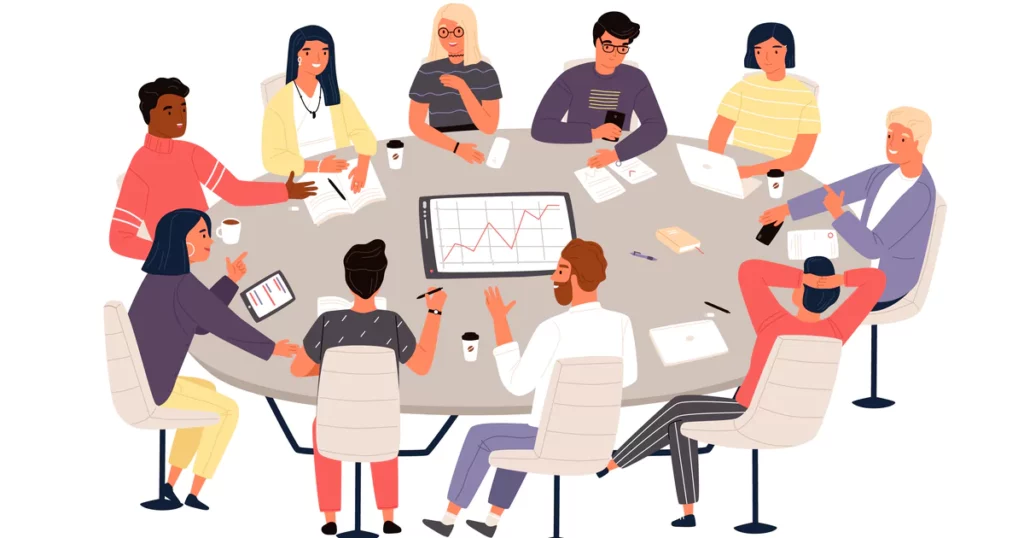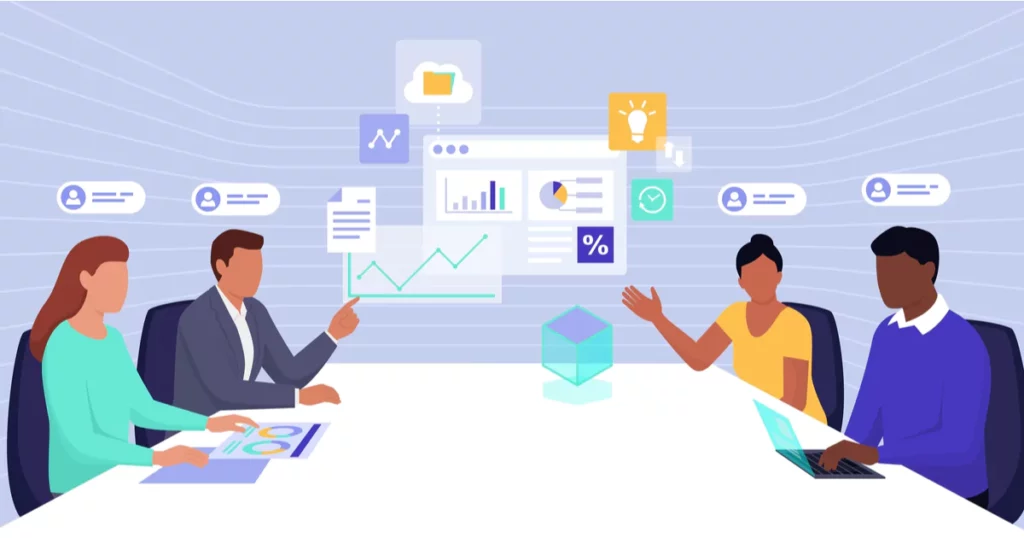Everyone loves an effective meeting, but the question often is, how do we get there? There are practical steps every manager can take to make sure they’re using meetings as a tool and not a hindrance to their team. Whether you’re meeting with an employee one-on-one or leading a team meeting, we’ve got your guide on how to make a meeting as effective as possible.
Table of Contents
What are the characteristics of an effective meeting?
11 tips for effective meetings
What are the characteristics of an effective meeting?
An effective meeting achieves its original objective, uses time wisely, and by the end of it, attendees are clear about what to do next. There are different ways you can ensure that these things happen, but as you begin planning for your next meeting, keep these three goals in mind.
Effective meetings, more than anything, are run with intentionality. Without putting thought into your meeting, you leave the door open for anything to happen, which proves to be frustrating for employees. Surveyors at Deputy found that 25% of Americans would rather sit in traffic than be in a meeting, and 17% would rather be on jury duty. Basically, meetings can be more tedious than some of the most mundane parts of American life!
Luckily, if a meeting is run well, it can actually boost employee engagement. Employees will feel like they’re contributing something valuable to your organization, which increases their company loyalty and desire to see your team succeed. High levels of employee engagement are correlated to higher productivity, positivity, less absenteeism, increased retention, and more. If you’re wondering why it’s important to run an effective meeting, consider the greater impact it can have on your organization! Let’s take a deeper look at our three characteristics of an effective meeting so you can boost engagement and have a positive work environment.

Achieving the objective
An objective is your main goal for the meeting. Ask yourself what outcome you want from your meeting. Are you trying to accomplish something or brainstorm for the start of a new project? Is there a problem you’re aiming to solve or a decision that needs to be made?
For an effective meeting, keep your list of objectives as small as possible—only one objective is ideal, and of course, you may have to make smaller decisions along the way to fulfill that one objective.
Using time wisely
On average, Americans spend almost four and a half hours every week in meetings. Additionally, Forbes reports that most senior managers view meetings as a waste of time, keeping them from productivity and even deep thinking! If the general consensus is that meetings are tedious and can even be a waste of time, but you know that they are inevitable, you can change your team’s perspective by using meeting time wisely.
Don’t just watch the minutes tick by—stay on top of an agenda or a schedule so that you can maximize your time and get to everything you want to.
Giving clarity on next steps
Meetings are surely a waste of time if you leave after an hour and don’t know what to do next. In order to have good employee engagement where employees feel productive and that their talents are valuable to your company, you must provide clear and attainable next steps after a meeting. Depending on the project and the staff involved, you can manage as needed outside of the conference room. Giving clear next steps during or after a meeting also reduces how much micromanaging you’ll need to do. Not only will your employees feel empowered but you’ll actually be freer to do other important tasks.

Leading effective meetings
So, what does it look like to lead an effective meeting? What do you need to take into consideration if you want to meet your objective, use time wisely, and give clear next steps to your employees? And what leadership skills are necessary to make that happen?
First of all, decide whether or not your meeting is important. Before you say, “Of course my meeting’s important—we have stuff to do!”, think through how much of what needs to be decided can just be sent through an email. You still want to communicate with the necessary people to get the job done, but not every decision has to be made in the context of a scheduled meeting.
Second, consider how you will communicate your main objective to your meeting participants. If you have more than one person attending your meeting, think of what communication style works best for them. Who’s more likely to read through a document assigned before your meeting, or is it best for you to quickly stop by someone’s desk and give them a 60-second rundown of what they’ll need for your meeting? How can each meeting attendee fully grasp what your goal is and their part to play?
Lastly, plan and prepare. Don’t blindly go into a meeting, hoping that your agenda will work itself out or that you can wing each discussion point. If needed, practice your meeting and the transitions that you’ll make between each topic. It will be obvious to your employees if you yourself were prepared for the meeting that you’re leading. Just like you hope that they’ll do any pre-meeting work or bring their ideas to the table, you must be able to lead the pack in that work.
The more intentional you are about how you lead a meeting, the less tension you’ll feel during and after that meeting. Remember, a good, effective meeting is important for high employee engagement. There’s more to gain than just a smooth hour where decisions were made. Your work culture and overall company can benefit through establishing a rhythm of effective meetings.

11 Tips for effective meetings
Now that you know what makes a meeting effective and you’ve got the mindset of leading one, here are some tips that can help you do just that. Your company and industry might have different ways of doing each of these points, but be sure that you stick with these basic principles. If you’re able to set an expectation that every meeting you host will be effective, your team will come to those meetings attentive and ready to be productive.
1. Have a clear objective.
Before your meeting actually happens, know what outcome you want to leave with. Everything that your team discusses in your meeting should lead to that particular outcome. Sit down ahead of time and break down what it is that you need. If you’re meeting for an extensive project, ideate more than “Plan project” for your objective. Create tangible objectives that you are confident will be met.
One thing you want to make sure you do is share that objective with the other participants! They might be able to figure out why they’re sitting in that meeting with you, but let them know exactly what their goal is. What’s good about a meeting is that it gets multiple people on the same page to accomplish the same goal.
2. Have a clear agenda.
Having a clear agenda (and one that’s written out!) is key to leading an effective meeting. Much like your clear objective, your agenda should be accessible to everyone who will be at your meeting. Make sure that you share the agenda with them ahead of time. This will give everyone a chance to prepare ahead of time and be able to give the best contribution they can. Since other people will be viewing your agenda, help them out by making it as clear and detailed as possible.
An agenda also helps you stay on course throughout the meeting. Remember—an effective meeting uses time wisely, and following the guidance of a pre-set agenda can help you do just that. It’s helpful to follow the agenda items in their given order, but feel free to be flexible. As you’re sitting in the meeting, you might realize one topic is more logical to go through before another, or you might even realize one topic requires a separate meeting altogether.
3. Invite the right people.
You want the right people in the room with you that can help accomplish your objective. Strategically creating a guest list leads to more productivity in the long run! You know that all your coworkers’ opinions are worth being heard, but it’s up to you to be decisive about who has a say in your effective meeting.
One thing to keep in mind is that the more people you invite, the longer it can take to meet your objective. While many hands can lighten a load, many voices take a long time to listen to. Looking at data from Stanford University, Inc. concluded that the optimum number of participants for a meeting is between five and nine people.
When you’re sending those invitations, include people who can provide unique perspectives. Ask yourself, “Is this person needed at this meeting?” If the answer is no or you take an extended time to answer it, consider removing their email address from the list. And speaking of invitations . . .
4. Send the meeting invitations at the right time.
Sending meeting invitations might seem like a small administrative task, but if you want to lead an effective meeting, timing is everything so that participants can prepare properly.
If you send out your invitations too early, that can cause people to put off preparing for it. Upon seeing that far away meeting date, they might even forget to look over your agenda or even add it to their own calendar. On the other hand, if you send out an invitation too late, the people that you want to join you might have prior obligations. They also won’t be able to prepare well for your meeting, which could slow down the time it takes for you to go through your agenda.
5. Start and end on time.
An easy way you can use your time wisely and run an effective meeting is to start and end on time. Whether you schedule a quick, fifteen-minute meeting or have an extensive, hour-long meeting to close out a big project, respecting everyone’s time by sticking to the set time frame is a good rhythm to put into practice. Your employees and coworkers will recognize that you value their time and that you can stick to your word, and it gives you a healthy challenge to make it through your whole agenda before the end of the meeting.
Keep in mind that if you’re approaching the end time faster than you anticipated, you still don’t want to rush through agenda items too quickly. If you don’t make it through everything you hoped to, set another meeting, maybe with a smaller group of people, or be okay with not hitting everything.

6. Start well.
Open your meeting with excitement and create a positive expectation for your team! There are a couple of ways you can do this, including asking ice breaker questions or doing a quick team building activity. You can even do something as simple as thanking everyone for being there and casting a vision for what you hope to accomplish together.
The way you start your meeting sets the tone for the rest of your time together, especially if you are working on a longer-term project. If you want an effective meeting with collaborative participants and productive discussions, make sure you open up the floor at the beginning of the meeting for people to feel comfortable and wanted.
7. Encourage participation.
This one goes hand-in-hand with inviting the right people to your meeting. If even one of the attendees is silent for a majority of the meeting, then you might have made a mistake in that invitation. Or, chances are, that person just needs a little nudge to speak up.
Meetings shouldn’t run like lectures. While you can give yourself space to teach or educate the group on something relevant to your objective, a small portion of the group shouldn’t dominate the meeting. Everyone in attendance should have something to contribute; besides, you chose the right people to be there. You can even include a quick team building activity to break the ice, and get people talking.
Encouraging participation in this meeting leads to meeting attendees continuing to work toward your objective even after the meeting is over. They might simply give feedback on others’ ideas or back up someone else’s conclusion, but remind those in your meeting that they’re now working as a team for something great.
8. Pay attention (and ask others to do the same).
This should go without saying, but make sure that you pay attention in your meeting and that others are also! You might find, especially for longer meetings, that people’s attention span seems to dwindle. Maybe they’ve got their computers or phones out preparing for their next meeting or a deadline they’ve got coming up, or maybe they’re just distracted. For a meeting to be as effective as possible, you want your team to be able to participate, and that can be difficult if someone isn’t fully present. It’s natural to zone out for a moment, so find ways to keep everyone’s attention. One of the easiest ways to do that is pushing through your agenda—know when one item is fully discussed and it’s time to move to the next one.
9. Take notes or record your meeting.
Taking notes during a meeting helps you remember decisions that were made, as well as decisions that were not made. Notes are helpful to jog people’s memories after your meeting is over and when they have to do any practical things that you talked about in your meeting. If you have recording capability, like if you’re running a virtual meeting or have a tool like Otter.ai that can capture audio and transcribe it, then consider recording your meeting so you can go back and review your meeting.
The idea of taking notes seems like an easy one, but assign this task to someone who isn’t leading the meeting and who can easily sum up things as they’re being stated. This task might go to an assistant, but you can give this responsibility to anyone who can pay attention and stay organized!
10. Provide visual aid.
For an effective meeting, make sure you take the time to create a good, clear visual aid. This can include a slide deck, examples of your outcome (say, if you’re working on a new product or design), and your meeting agenda. If you take the time to work on these, they can help your meeting flow seamlessly. Visual aids help your staff stay focused on what you’re saying or get a better idea of what you’re accomplishing together. Giving your team a visual also helps everyone stay on the same page—in the likely case that someone zones out for a moment, they can easily look around and see what the current topic is.
11. Review and debrief.
At the end of your meeting when you’ve thoroughly gone through each agenda item and made the best decisions possible, go over those decisions! Leave a few minutes at the end of your meeting that can be dedicated to reviewing what your team talked through and what tasks are next. The last thing you want is for everyone to step out of the conference room or log off of Zoom and freeze, wondering what exactly their next steps are. Even though you’ve taken notes that everyone will have access to, verbally state what decisions were made and point out what each attendee should do next. You can even go around the room (or screen) and let everyone give one sentence of final feedback or allow them to ask any questions.

Effective One-on-One Meetings
You can utilize one-on-one meetings for as many different reasons as you can think of, but the bottom line is that they’re just two people having a conversation. The Harvard Business Review suggests that you give open-ended questions to keep the conversation going and that you start with positive news or by building rapport. For effective one-on-one meetings, you can still use our tips mentioned above, especially having a clear agenda or giving discussion points for your meeting.
If possible, meet face-to-face so that you have the best communication possible. You’ll be able to read each other’s body language as well as understand the words that you’re speaking. If you’ve set a regular meeting with individual members of your team, make sure they’re well aware of the goal of your meeting, and block it off regularly on your calendars.
One-on-one meetings are great ways to boost employee engagement as well, as you have an opportunity to build relationally with an employee and direct them in how they’re doing well and in areas they can improve. These meetings can show them that you care about them as an individual and that you want them to continue succeeding in your industry.
Effective Team Meetings
When most people think of a meeting, they think of a team getting together to accomplish something or make decisions. Team meetings can also be great for trainings, team onboarding, or consistent times for a team to touch base with one another about their work for the day or week.
To lead an effective team meeting, keep in mind the people who are joining your meeting. If you’ve worked with them before, think about what their attention spans might look like and what kinds of things will keep them engaged in your meeting. Don’t bring up topics that don’t need to be discussed—if there’s a smaller portion of your team that is necessary for a specific project or agenda item, leave that for another meeting.
One thing that easily happens in team meetings is that people will go off on rabbit trails. For an effective team meeting, manage the rabbit trails! It’s okay to have fun at work, and discussion topics can likely remind someone of something else that’s not related to your overall objective. But if you sense that your team is going a little too off-topic, make sure you reel them back into your agenda.

Effective Virtual Meetings
Virtual meetings can still be as effective and productive as in-person meetings. You have the added element of technology, which can either be a burden (like if someone’s Internet connection cuts out) or you can use it to your advantage (like if you want to record the meeting). Virtual meetings also give you ways to share your screen if you have a slide deck to present, and you can drop helpful and relevant links in the chat if you want to direct your team to something online.
For an effective virtual meeting, keep your meeting engagement as high as possible. Request for your team to keep their cameras on if they’re comfortable. For a smaller meeting team, they can even stay unmuted. Ask questions to everyone throughout the meeting and make sure that everyone participates in your review and debrief time. Refer to the meeting agenda often and draw your employees’ attention back to the ultimate objective.
As technology continues to develop and virtual meetings become easier and easier to run, stay ahead of the curve in making these meetings effective. Use technology to your advantage as much as possible, and be aware of any learning hurdles that your team might face as different platforms run updates or new tools become available. Learn more here about increasing your executive presence in a virtual meeting.
Conclusion
As you start implementing these tips in your meeting habits, you can expect increased participation and productivity in your overall workplace. Effective meetings give employees clarity on what their jobs are and how you’re working together to achieve something! Even if you start making small changes today about how you plan and run your meetings, you’ll begin to see better, more productive work being done by a staff who knows what they’re doing.

